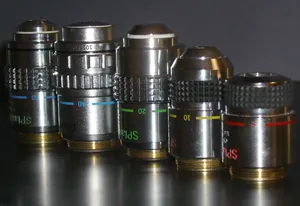Light microscope objective lenses
Magnification is important, but so are NA and WD.
Many of us have looked though the eyepiece of a department store microscope and seen a fuzzy looking “something” with the highest magnification objective lens. It’s not completely surprising that an inexpensive lens would give a blurry image. There are many optical aberrations that need to be corrected to manufacture the expensive lenses that are used on research grade microscopes.
What’s the best I can see?
Light microscopes can, under the best conditions, resolve objects that are approximately equal to half the size of the wavelength used. In the real world this comes out to objects that are 250-300nm in size, if you are using a NA=1.4 objective lens (under optimal conditions). This means that you can make out two adjacent objects in this size range, assuming that you can see at least a 25% dip in intensity between them (Rayleigh criterion). Sample preparation is especially important when you want to resolve structures this small.

So what is NA anyway?
Numerical Aperture (NA) is “… a critical value that indicates the light acceptance angle, which in turn determines the light gathering power, the resolving power, and depth of field of the objective.”(1) As light passes through a sample, the information describing the highest resolution information in the sample is diffracted at a very wide angle. Low magnification lenses typically have low NAs, meaning that they cannot capture the highest resolution information. To capture the widely diffracted information, high NA lenses move the front of the lens closer to the sample (increases the light acceptance angle). Dry lenses can only have NAs of up to 1.0. By using specially formulated oil and oil lenses, NAs of up to 1.4 can be achieved.
Web tutorials that explain NA in more detail:
- Numerical Aperture and Image Resolution - http://micro.magnet.fsu.edu/primer/java/imageformation/airyna/index.html
- Numerical Aperture Light Cones - http://micro.magnet.fsu.edu/primer/java/nuaperture/index.html
- Immersion Oil and Refractive Index - http://micro.magnet.fsu.edu/primer/java/microscopy/immersion/index.html
Nothing in the world of physics & optics is “free”
The “cost” of obtaining a higher NA is that the working distance (WD) of the lens becomes much shorter. Working distance is “… the distance between the objective front lens and the top of the cover glass when the specimen is in focus. In most instances, the working distance of an objective decreases as magnification increases.” (1) A smaller working distance can be a problem when you cannot see an object with a high magnification lens, even though you could see it with a low magnification lens. A 10x objective can have a WD of several millimeters (4-10mm, or 4000-10,000um). A well corrected, high NA 20x dry objective will have a WD of slightly less than 1mm (1000um). Most well corrected, high NA 40x and 60x oil objectives have working distances on the order of 0.1mm (100um).
The bottom line
High magnification without high NA does not give the resolving power that most people expect from a research grade microscope. Using a high NA objective lens means that you are most likely sacrificing working distance (how deep into the sample that you can focus) for higher optical resolution. In most instances this is a very acceptable trade off.
References: 1) http://micro.magnet.fsu.edu/primer/anatomy/specifications.html
Reviewed & updated 06/16/2017. Creation of this web page was originally supported as part of the Southwest Environmental Health Sciences Center at the University of Arizona, NIEHS P30 ES006694.

